Download ASL INTERCOM PS 430 User manual
Transcript
PRO SERIES
USER MANUAL
FOR THE
PS 278
DUAL CHANNEL MASTER STATION
CONTENTS
1.0
2.0
3.0
4.0
5.0
6.0
7.0
8.0
9.0
10.0
11.0
12.0
GENERAL DESCRIPTION . . . . . . . . . . . . . . . . . . . . . . 1
UNPACKING . . . . . . . . . . . . . . . . . . . . . . . . . . . . . . . . . 1
MECHANICAL INSTALLATION . . . . . . . . . . . . . . . . . . . 1
MAINS POWER . . . . . . . . . . . . . . . . . . . . . . . . . . . . . . . 2
FRONT PANEL CONTROLS . . . . . . . . . . . . . . . . . . . . . 4
REAR PANEL CONTROLS AND CONNECTORS . . . . 6
INTERNAL CONTROLS . . . . . . . . . . . . . . . . . . . . . . . . 7
CABLING . . . . . . . . . . . . . . . . . . . . . . . . . . . . . . . . . . . . 8
PARTY LINE, TECHNICAL CONCEPT . . . . . . . . . . . . . 9
GUARANTEE . . . . . . . . . . . . . . . . . . . . . . . . . . . . . . . . . 9
DESIGN CRITERIA . . . . . . . . . . . . . . . . . . . . . . . . . . . . 9
TECHNICAL SPECIFICATIONS . . . . . . . . . . . . . . . . . 10
User Manual PS 278 / Issue 2 © 1996 ASL Intercom, Utrecht, Holland.
1.0
GENERAL DESCRIPTION
The PS 278 is designed to be a master unit in an ASL
intercom system and can be used in portable as well as
fixed applications. It incorporates a dual channel intercom
line power supply, a dual channel headset station, an
audio input and uses only 1U of 19" rack space.
This makes the PS 278 very versatile and ideal for use in
applications where standard microphone cable is available
and ease of setup is of paramount importance.
Each channel has a Volume (listen level) control, a Talk
and a Call button with LED indicators and a sidetone
trimmer.
The intercom line power supply is fully protected and can
drive at least 20 beltpacks or 10 speaker stations, or a
combination, operating at full power. The power supply is
completely separated from all other functions and in case
of power failure the unit can accept line power from an
external ASL power supply.
Since the power supply provides the line impedance, only
one PS 278 should be used on the two channels. For
driving more beltpacks/speaker stations on these lines an
additional power supply booster (PS 285) is needed.
Special attention has been paid to the intelligibility of
speech. By applying low noise/high speed circuitry,
a speech presence filter and a specially designed high
power headphone amplifier, communication is very
comfortable even in environments with a high background
noise level.
2.0
The unique ASL CALL system provides both a flashing red
LED and a very distinctive and characteristic sound signal.
Only a slight touch of the CALL button will make the LED
flash, whilst holding the button for two seconds will activate
the call sound signal. In case the sound signal is
undesirable, all buzzers can be muted with the front panel
'all buzzers on/off' button.
Fully electronic switching increases reliability and allows
for :
- 'soft' microphone ON switching, latched or momentary
- remote Mic Mute facility. All microphones of stations
connected to the PS 278 can be muted by pushing a
single front panel button.
An Aux input on the rear panel, allows injecting external
audio signals of line or mic level. When 'mic level' is
selected, +30 V phantom power is available at the Aux
input connector.
An Aux signal can be routed to intercom line A and/or B, or
directly to the local headset.
As an option, a XLR-6 headset connector can be fitted,
allowing the user to hear channel A + AUX program signal
on the left headset can and channel B + AUX program
signal on the right headset can. By changing the position
of internally mounted jumpers, it's also possible to hear
channel A + B on the left can and the AUX program signal
on the right can.
UNPACKING
The shipping carton contains the parts listed below.
* The PS 278
* Power cable
* Spare fuses
* User manual
If any are missing contact your dealer.
ASL has taken great care to ensure that this product
reaches you in flawless condition.
After unpacking the unit please inspect for any physical
damage to the unit, and retain the shipping carton and
relevant packing materials for use should the unit need
returning.
With the PS 278 will be a small packet of spare fuses.
Please keep them in a safe place.
There is also one spare fuse included in the mains inlet.
If any damage has occured, please notify your dealer
immediately so that a written claim can be initiated. Please
also refer to the guarantee section of this manual.
3.0
MECHANICAL INSTALLATION
A vertical rack space of 1U (1.75", 44mm) is required for
the PS 278. It is not necessary to provide rear support by
extra bracing or shelving.
Adequate ventilation must be provided by allowing
sufficient space around the sides and rear of the unit to
ensure free circulation of air. Forced cooling is not
User Manual PS 278 / Issue 2 © 1996 ASL Intercom, Utrecht, Holland.
required.
The power supply regulator is mounted on the rear of the
unit, and after a period of time it will feel hot to the touch.
This is quite normal, and should be no cause for alarm.
1
4.0
MAINS POWER
The PS 278 may be connected to the mains power outlet
to which other audio equipment is connected. The outlet
should have a clean safety earth. Avoid using mains
power outlets which also power dimmer controlled lighting
equipment.
IMPORTANT
The wires in this mains lead are colour coded in
accordance with the following code:
green and yellow Earth / safety ground
blue
Neutral
brown
Live
Before connecting the unit to its AC power source, check if
the mains voltage setting is set in accordance with your
local mains voltage. The voltage setting is indicated by a
label on the rear panel.
If a change is necessary, the internal mains transformer
wiring will need to be reconnected as shown in section 4.3
Mains Power settings.
Remember that the AC mains fuse will need to be
changed for one of the correct rating as indicated.
The power cord supplied with this unit carries the following
information label:
As the colours of the wires in the mains lead may not
correspond with the coloured markings identifying the
terminals in your plug, proceed as follows:
-
-
-
WARNING
This appliance must be earthed
The wire which is coloured green-and-yellow must be
connected to the terminal in the plug which is marked
with the letter "E", or by the earth symbol which is
or
coloured green.
The wire which is coloured blue must be connected to
the terminal which is marked with the letter "N" or
coloured black.
The wire which is coloured brown must be connected
to the terminal which is marked with the letter "L" or
coloured red.
Those units that are supplied to the North American
market will have an integral moulded 3 pin connector
which is provided to satisfy required local standards.
4.1
SAFETY EARTHING
The green-and-yellow wire of the mains cord must always
be connected to the electrical installation safety earth or
ground. It is essential for personal safety as well for proper
operation of the PS 278 and the other connected stations.
This wire is internally connected to all exposed metal
surfaces and any rack framework into which this unit might
be mounted is assumed to be connected to the same
grounding circuit.
The PS 278 employs professionally designed audio input
and output circuits which do not require the disconnection
of any safety earth for the avoidance of hum loops.
2
User Manual PS 278 / Issue 2 © 1996 ASL Intercom, Utrecht, Holland.
4.2
POWERING UP
Powering up procedure:
-
Make sure that the red power switch on the left side of
the front panel is OFF.
-
Connect the power cord to the rear of the station.
-
Plug the other end of the power cord into a
PROPERLY GROUNDED outlet.
-
Turn on the power with the red button. The red
overload LED will light up for about 3 seconds, then
extinguish and then the green power LED will go on,
indicating that the station is active.
4.3
MAINS POWER SETTING
Voltage settings (Top View)
See also section 4.0 Mains Power
Setting for 115 V AC Voltage:
1. Red + Green
2. Empty
3. White + Yellow
Setting for 230 V AC Voltage:
1. Red
2. White + Green
3. Yellow
Mains Fuse
100 - 120V
220 - 240V
T 630 mA
T 315 mA
User Manual PS 278 / Issue 2 © 1996 ASL Intercom, Utrecht, Holland.
3
5.0
4
FRONT PANEL CONTROLS
1
POWER ON/OFF switch
Mains power push button for switching ON and OFF
the internal power supply.
7
ALL BUZZERS ON/OFF button
With this button all buzzers of the connected stations
can be muted.
2
OVERLOAD LED
This LED illuminates if the internal power supply has
shut off line power due to overload.
If the internal power supply is overloaded (too many
user stations are connected, or short-circuit in the
interconnecting cables, or thermal overload), it
activates a circuit-breaker which immediately shuts off
line power. This circuit breaker resets automatically
3 seconds after the overload situation is terminated,
restoring line power automatically.
During short-circuit, the LED will flash every 3
seconds. During thermal overload it will remain on
continuously.
The LED will also come on for a few seconds every
time you switch on the mains power.
8
AUX VOLUME control knob
This knob adjusts the level of the aux input signal
before it is sent either to the intercom line(s) or to the
headset (see also section 5.8).
9
A/B/HEADSET routing switches
These three switches route the aux input signal to
either:
1) Intercom channel A and/or Intercom channel B
2) Directly to the headset
If the aux is routed to the headset the aux is for local
monitoring only, and can not be routed to the intercom
channels.
3
POWER LED
This LED illuminates if line power is supplied by the
internal power supply.
4
BUZZER
This buzzer indicates an incoming our outgoing call.
It is activated by pressing a CALL button of the PS 278
or a CALL button of any other station on channel A or
B for longer than two seconds and the buzzers are not
muted (see 5.7). You can adjust its volume with the
buzzer volume control.
5
BUZZER VOLUME trimmer
This trimmer adjusts the volume of the buzzer.
6
ALL MIC'S ON/OFF button
With this pushbutton all microphones of the connected
stations can be muted.
User Manual PS 278 / Issue 2 © 1996 ASL Intercom, Utrecht, Holland.
5.0
FRONT PANEL CONTROLS
10 VOLUME control knobs
These knobs adjusts the listen level for the headset.
Each channel can be adjusted separately.
11 SIDETONE trimmers
These trimmers adjust the level of your own voice as
you hear it in your headset.
Adjustment procedure :
- set the trimmer in start position: fully clockwise.
- switch off the microphone of all connected
(speaker!) stations.
- switch on the microphone of the required channel.
- turn up the volume of the required channel.
- speak into the headset microphone.
- adjust the listen level by turning the sidetone
trimmer.
The operating area is between fully clockwise and
minimum level. Adjusting the sidetone does not affect
the level of your voice as it is heard by other stations.
12 TALK buttons
These buttons allow you to talk to each channel
separately or simultaneously.
The large green LED indicates if the talk function is
activated.
Latched switching:
When a TALK button is momentarily pressed, the
microphone will be switched on for the chosen channel
and is electronically latched. When pressed again, the
microphone will be switched off.
13 CALL A & B buttons
These push buttons activate the CALL system.
A momentary push will send a CALL signal to all
stations connected to that intercom channel and the
CALL LEDS will start flashing.
Press and hold the buttons for 2 seconds will activate
the call buzzer, if not muted.
After the CALL button is released the LEDS will
continue to flash for a further 2 seconds.
14 HEADSET connector
A XLR-4 type connector for the connection of the local
headset. This must have a can impedance of 200
ohms (or greater), or each 400 ohms minimum when in
parallel. The mic may be of the dynamic or electret
type.
Pin assignments:
1. shield mic. (GND)
2. mic. +
3. phones +
4. phones The wiring is such that both headset cans are
connected in parallel and receive the same signal. The
two headphone amplifiers run in a bridged mode.
As an option, a XLR-6 type connector can be fitted to
give a binaural headset configuration where a different
signal will appear on each can. In this mode the
internal headphone amplifiers are not bridged.
See section 7.1 Internal Jumpers and Controls.
Momentary switching:
When a TALK button is pressed and held, the
microphone will be switched on, and when released,
will be switched off.
User Manual PS 278 / Issue 2 © 1996 ASL Intercom, Utrecht, Holland.
5
6.0
REAR PANEL CONTROLS & CONNECTORS
15 A & B LINE connectors
These XLR-3 type connectors are for connecting the
remote-stations, via standard microphone cable.
There are two connectors for channel A and two
connectors for channel B.
Pin assignments :
1. 0 V / ground shield
2. +30 V power wire
3. audio wire
18 MAINS INLET
IEC Mains connector. For correct wiring and operation
refer to section 4.0.
WARNING
Before you plug in the mains voltage, check if:
The fuse is correct
The voltage is correct
16 AUX INPUT connector
This XLR-3 type aux input is electronically balanced
and accepts audio levels between -18dBu to +22dBu
on line level, and -38dBu to +2dBu on mic level.
Pin assignments :
1. 0 V / ground
2. Signal +
3. Signal When mic level is selected, a +30Vdc phantom power
is supplied to pins 2 and 3.
17 FUSE
This fuse protects the PS 278 against severe internal
damage, in case of malfunction in the power section.
To remove the fuse the mains cord must be removed.
It is most important to place the correct fuse in the
holder :
mains voltage
fuse
220 - 240 VAC T 315 mA
100 - 120 VAC T 630 mA
Spare fuses will be found in the small packet supplied
with the unit.
6
User Manual PS 278 / Issue 2 © 1996 ASL Intercom, Utrecht, Holland.
7.0
INTERNAL CONTROLS
MIC GAIN
The mic gain can be adjusted internally.
-
Open the PS 278 with the two top screws at the
frontpanel and the two screws top side
The trimmer is located at the right front of the unit.
To increase mic gain turn clockwise.
To decrease mic gain turn counterclockwise.
See section 7.1 for the location of the mic gain trimmer.
7.1
INTERNAL JUMPER SETTINGS AND CONTROLS
Binaural Jumper settings
See also section 5.0 -14 HEADSET connector
The binaural configuration is set by internal jumpers J3,
as follows:
Jumpers in position A
Left can
channel A and B.
Right can
AUX-signal.
Jumpers in position B
Left can
channel A and AUX-signal.
Right can
channel B and AUX-signal.
Internal mic gain
See also section 7.0 - Internal Controls
The mic gain trimmer is labeled:
P2 for the mic gain setting.
User Manual PS 278 / Issue 2 © 1996 ASL Intercom, Utrecht, Holland.
7
8.0
CABLING
For the PRO Series Intercom system the interconnecting
cables are of the shielded two-conductor microphone
cable type and the intercom line connectors are of the
XLR-3 type. Audio and Call signals are on XLR pin 3, DC
power is on XLR pin 2. XLR pin 1 is connected to the
shield of the cable which functions as the common return
for audio and power.
¼
Since the audio signal is transferred in an unbalanced
way, certain rules have to be obeyed when installing the
cables of an intercom network. This is to avoid earth loops
and to minimize power loss and the possible effect of
electromagnetic fields.
These rules are:
Use high quality (multipair) cable.
For interconnecting user stations, power supplies and
accessories in an ASL Intercom network, use high
quality shielded two-conductor (minimum 2x 0.30 mm2)
microphone cable only.
In case of a multi channel intercom network, use high
quality microphone 'multipair' cable only, each pair
consisting of two conductors (minimum 2x 0.15 mm2)
with separate shield. Multipair cable should also have
an overall shield.
Use flexible cables.
Use flexible single and multipair microphone cable
instead of cable with solid cores, especially when the
cable is subjected to bending during operation or
installation.
Separate cable screen to XLR pin 1.
The screen of each separate microphone cable and/or
the screen of each single pair in a multipair cable,
should be connected to pin 1 of each XLR-3 connector.
Do not connect this cable screen to the metal housing
of the connector or to metal wall boxes (outlets).
See page 13 for Earthing Concept.
Cable trunks, connection boxes and overall
multipair cable screen to clean earth.
Metal cable trunks, metal connection boxes and overall
multipair cable screen should be interconnected and,
at one point (the 'central earthing point') in the intercom
network only, be connected to a clean safety earth.
See page 13 for Earthing Concept.
Keep metal connection boxes and cable trunks
isolated from other metal parts.
Metal housings for intercom cables and connectors
should be mounted in such a way that they are isolated
from other metal cable and connector housings and
from any other metal construction parts.
¼ See Party Line, Technical Concept
8
Keep cables parallel as much as possible
When two (multi channel) units in a network are
connected by more than one cable, make sure that
these cables are parallel to each other over the whole
distance between those units. When using multipair
cable, parallelism is ensured in the best possible way.
Avoid closed loops.
Always avoid that cables are making a loop. So-called
'ring intercom' should not physically be cabled as a
ring. All cable routes should have a 'star' configuration,
with the central earthing point (usually close to the
power supply position) as the centre of the star.
Keep cables away from electromagnetic sources.
Keep intercom cables away from high energy cables,
e.g. 110/220/380V mains power or dimmer controlled
feeds for spotlights.
Intercom cables should cross high energy cables at an
angle of 90( only.
Intercom cables should never be in the same trunking
as energy cables.
Place power supplies in a central position.
In order to avoid unacceptable power losses, place the
power supplies as close as possible to where most
power consumption occurs or, in other words, most
user stations are placed.
Connect ASL power supply to a 'clean' mains
outlet.
The ASL power supply may be connected to the mains
power outlet to which other audio equipment is
connected. Avoid using mains outlets which also power
dimmer controlled lighting systems.
In case of more complex installations, don't hesitate to
contact us. Please send us a block diagram of the
planned network with a list of all user stations and their
positions, and we are happy to advise you on cabling
lay-out.
User Manual PS 278 / Issue 2 © 1996 ASL Intercom, Utrecht, Holland.
9.0
PARTY LINE, TECHNICAL CONCEPT
ASL's PRO Series offers a complete two way ('full duplex')
communications system.
Users of the system are connected via a 'party line'.
Master stations (with built-in power supply), beltpacks,
speaker stations and power supplies are interconnected
via standard microphone cable. One wire is used as an
audio line, one as a power line and the screen of the cable
functions as earth/return.
Current drive is used for signal transfer. Each station
utilises a current amplifier to amplify the microphone signal
and place it on the common audio line where, due to the
constant line impedance (situated in the power supply
between XLR pin 3 and 1), a signal voltage is developed
which can be further amplified and sent to headphones or
loudspeakers.
This principle has three advantages:
- the use of a single audio line allows several stations to
talk and listen simultaneously.
- due to the high bridging impedance offered by each
station, the number of stations 'on line' has no
influence on the level of the communications signal.
- power and audio to the intercom stations use the same
cable.
The Call signal is also sent as a current on the audio line.
It develops a DC potential over the line impedance which
will be sensed by each station and interpreted as a Call
signal.
10.0
GUARANTEE
11.0 DESIGN CRITERIA
Applications / Environment of use
ASL Pro Series equipment is designed for use as a wired
communications system in theatres, in Radio/TV
production facilities, in factories, and in utilities complexes
such as airports, railway stations and coach terminals.
ASL equipment can be used outdoors in normal weather
conditions. In conditions with excessive cold (<-10( C),
heat (>50( C) or humidity (>85%), ASL equipment might
not perform properly.
ASL equipment is not designed to be used under water, or
in situations where explosion safe equipment is specified
by authorities.
Emission
ASL Pro Series equipment does not generate high
frequency (HF) signals. An ASL power supply can
generate a weak magnetic field caused by the power
transformer. To avoid possible negative effects, keep ASL
power supplies at a safe distance from equipment which is
very sensitive to magnetic fields.
Immunity
ASL Pro Series is designed on the base of low impedance
signal transport. User stations and power supplies are to
be connected via low capacity cabling with an overall
screen (see also Cabling section). Therefore, HF signals
are adequately rejected to maintain an intelligible
communication, unless strong electro-magnetic fields
(exceeding 3V/m) are in the direct vicinity of the interconnecting cables.
ASL 19" rackmount units are housed in a 1 mm steel
enclosure (closed construction), which offers, by nature,
the highest possible rejection of electro-magnetic fields.
This unit is warranted by ASL Intercom to the original enduser purchaser against defects in workmanship and
materials in it's manufacture for a period of one year from
the date of shipment to the end-user.
ASL speaker stations (PS 130/230/430) are housed in an
enclosure made of 1 mm steel with ABS side panels,
which offers adequate rejection of electro-magnetic fields.
Faults arising from misuse, unauthorised modifications or
accidents are not covered by this warranty. If the unit is
faulty, it should be sent in it's original packing to the
supplier or your local ASL dealer, with shipping prepaid. A
note must be included stating the faults found and a copy
of the original suppliers invoice.
ASL beltpacks are housed in an ABS enclosure and are
slightly more sensitive to electro-magnetic fields. Negative
effects in the performance of beltpacks can be avoided
when keeping them on a safe distance from equipment
which might radiate strong electro-magnetic fields, such as
transmitter antennas and dimmers.
THIS PRODUCT WAS DESIGNED, DEVELOPED AND
MANUFACTURED BY :
AMPCO SOUND LAB BV
MAARSSEN (UTRECHT) HOLLAND
User Manual PS 278 / Issue 2 © 1996 ASL Intercom, Utrecht, Holland.
9
12.0 TECHNICAL SPECIFICATIONS PS 278
POWER SUPPLY
mains voltage range
115 V units: 100 - 125 V 60Hz AC
230 V units: 210 - 250 V 50Hz AC
DC output voltage
+30 V +/-5% DC
ripple and noise
< 11 mV rms
max. output current
1.7 A continuous / 3 A peak
circuit-breaker delay time
0.2 sec.
automatic reset time
3.0 sec.
AUX INPUT
input impedance
nominal input level
max. input level
phantom power
MIC. PREAMP
mic. impedance
gain
presence filter
frequency response
V electret mic
30 Kohms (balanced line level)
4.6 Kohms (balanced mic level)
-18 dBu to +6 dBu (line level)
-38 dBu to -14 dBu (mic level)
+22 dBu (line level)
+2 dBu (mic level)
+30 V DC (mic level selected)
200 ohms
40 dB - 70 dB (adjustable internally)
+6 dB at 5 kHz
200 Hz - 13 kHz (-6 dB)
+ 9 V DC
HEADPHONES DRIVER AMP
max. load
200 ohms
max. output level
normal 14 V rms (200 ohms)
binaural 8 V rms (400 ohms)
max. output power
normal 0.5 W rms (each can)
binaural 0.16 W rms (each can)
SIDETONE
rejection
0 - 30 dB adjustable
BUZZER
max. SPL
DIMENSIONS AND WEIGHT
width
height
depth
weight
100 dBA
19" (483 mm)
1U (44.5 mm)
150 mm
2.75 Kg
GENERAL SYSTEM SPECIFICATIONS
intercom line impedance
350 ohms (1kHz)
2.2 Kohms (DC)
intercom line audio level
nom. -18 dBu
max. +4 dBu
dynamic range
80 dB
call send signal
2.8 mA
call receive signal threshold
+2.4 V DC
supply voltage
+30 V DC (12 V to 32 V)
mic mute power interrupt time
0.1 sec
Note: 0 dBu = 775 mV into open circuit.
ASL reserves the right to alter specifications without further
notice.
10
User Manual PS 278 / Issue 2 © 1996 ASL Intercom, Utrecht, Holland.
User Manual PS 278 / Issue 2 © 1996 ASL Intercom, Utrecht, Holland.
11
12
User Manual PS 278 / Issue 2 © 1996 ASL Intercom, Utrecht, Holland.
User Manual PS 278 / Issue 2 © 1996 ASL Intercom, Utrecht, Holland.
13
14
User Manual PS 278 / Issue 2 © 1996 ASL Intercom, Utrecht, Holland.
User Manual PS 278 / Issue 2 © 1996 ASL Intercom, Utrecht, Holland.
15

















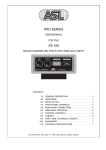
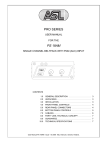
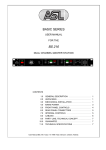
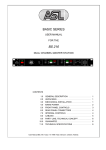


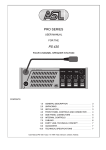
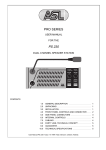
![User Manual PS 260 [ASL]](http://vs1.manualzilla.com/store/data/005875222_1-79f7ffd37f8e6cc3732f57605cc0b82b-150x150.png)